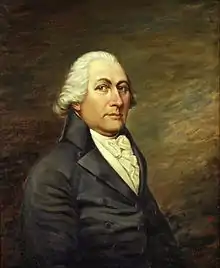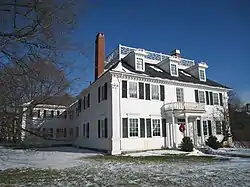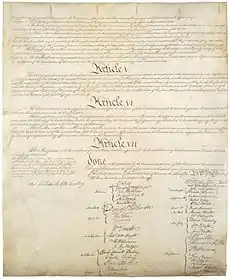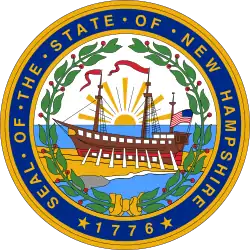John Langdon (politician)
John Langdon (June 26, 1741 – September 18, 1819) was a politician from Portsmouth, New Hampshire, and a Founding Father of the United States. He served as a delegate to the Constitutional Convention, signed the United States Constitution, and was one of the first two United States senators from that state.
John Langdon | |
|---|---|
 | |
| 2nd Governor of New Hampshire | |
| In office June 5, 1810 – June 5, 1812 | |
| Preceded by | Jeremiah Smith |
| Succeeded by | William Plumer |
| In office June 6, 1805 – June 8, 1809 | |
| Preceded by | John Taylor Gilman |
| Succeeded by | Jeremiah Smith |
| In office June 4, 1788 – January 22, 1789 | |
| Preceded by | John Sullivan |
| Succeeded by | John Sullivan |
| In office June 1, 1785 – June 7, 1786 | |
| Preceded by | Meshech Weare |
| Succeeded by | John Sullivan |
| President pro tempore of the United States Senate | |
| In office November 5, 1792 – December 2, 1793 | |
| Preceded by | Richard Henry Lee |
| Succeeded by | Ralph Izard |
| In office April 6, 1789 – August 9, 1789 | |
| Preceded by | Position established |
| Succeeded by | Richard Henry Lee |
| United States Senator from New Hampshire | |
| In office March 4, 1789 – March 3, 1801 | |
| Preceded by | Seat established |
| Succeeded by | James Sheafe |
| Personal details | |
| Born | June 26, 1741 Portsmouth, New Hampshire, British America |
| Died | September 18, 1819 (aged 78) Portsmouth, New Hampshire, U.S. |
| Political party | Pro-Administration Anti-Administration Democratic-Republican |
| Signature | |
As a member of the Continental Congress Langdon was an early supporter of the Revolutionary War. He later served in United States Congress for 12 years, including as the first president pro tempore of the Senate, before becoming governor of New Hampshire. He turned down a nomination for Vice Presidential candidate in 1812.
Biography
Early years
Langdon's father was a prosperous farmer and local ship builder whose family had emigrated to America before 1660 from Sheviock, Caradon, Cornwall. The Langdons were among the first to settle near the mouth of the Piscataqua River, a settlement which became Portsmouth, one of New England's major seaports. Langdon attended the local grammar school run by a veteran of the 1745 Siege of Louisbourg against the French at Fortress Louisbourg in New France. After finishing his primary education, he served an apprenticeship as a clerk. He and his older brother, Woodbury Langdon, rejected the opportunity to join in their father's successful agricultural livelihood and apprenticed themselves to local naval merchants instead.
To sea
By age 22, Langdon was captain of a cargo ship called the Andromache, sailing to the West Indies. Four years later he owned his first merchantman, and would continue over time to acquire a small fleet of vessels engaging in the triangle trade between Portsmouth, the Caribbean, and London. His older brother was even more successful in international trade, and by 1777 both young men were among Portsmouth's wealthiest citizens.
As revolutionary
British control of the shipping industries greatly hurt Langdon's business, motivating him to become a vigorous and prominent supporter of the revolutionary movement in the 1770s. He served on the New Hampshire Committee of Correspondence and a nonimportation committee, and also attended various Patriot assemblies. In 1774, he participated in the seizure and confiscation of British munitions from Fort William and Mary.
Langdon served as a member of the Second Continental Congress from 1775 to 1776. He resigned in June 1776 to become agent for the Continental forces against the British and superintended the construction of several warships including the Raleigh, the America, and the Ranger, which was captained by John Paul Jones. In 1777, he equipped an expedition against the British, participating in the Battle of Bennington and commanding Langdon's Company of Light Horse Volunteers at Saratoga and in Rhode Island.
Founding father

In 1784 he built at Portsmouth the mansion now known as the Governor John Langdon House. Langdon was elected to two terms as President of New Hampshire, once between 1785 and 1786 and again between 1788 and 1789. He was a member of the Congress of the Confederation in 1787 and became a delegate to the Constitutional Convention in 1787, serving as a member of the New Hampshire delegation. Langdon was elected to the U.S. Senate and served from March 4, 1789 to March 3, 1801. He was elected the first President pro tempore of the Senate on April 6, 1789, and also served as president pro tempore during the second Congress.
During the 1787 constitutional debates in Philadelphia, Langdon spoke out against James Madison's proposed "negative" on state laws simply because he felt that should the Senate be granted this power and not the House of Representatives, it would "hurt the feelings" of House members.[1] Langdon was an ardent supporter of the drive to ratify the Constitution of the United States in New Hampshire. On June 21, 1788 it was ratified by New Hampshire with 57-47 in flavor. He immediately wrote to George Washington to inform him that New Hampshire had become the ninth state which he described as the “Key Stone in the Great Arch. Joshua Atherton, who campaigned against ratification accepted the result and stated “It’s adopted. Let’s try it”.[2]
In 1798, Langdon assisted Oney Judge to evade Burwell Bassett, the nephew of George and Martha Washington, who had intended to kidnap Judge and return her to slavery with the Washingtons.[3]
New Hampshire statesman
Langdon later served as a member of the New Hampshire Legislature (1801–05), with the last two terms as speaker; he served as governor from 1805 to 1812, except for a year between 1809 and 1810. In 1808, his niece, Catherine Whipple Langdon, married Edmund Roberts.[4] Langdon declined the nomination to be a candidate for Vice President with James Madison in 1812, and later retired. He died in Portsmouth in 1819 and was interred at the Langdon Tomb in the North Cemetery.[5]
Legacy
The town of Langdon, New Hampshire is named after him,[6] as well as Langdon Street in Madison, Wisconsin, a city with numerous streets named after founding fathers.[7]
See also
- New Hampshire Historical Marker No. 114: North Cemetery
- New Hampshire Historical Marker No. 127: John Langdon (1741–1819)
References
- "Avalon Project – Madison Debates – July 10". Retrieved July 30, 2016.
- "A New Constitution for a New Nation, June, 6". Nashua Telegraph. 1988.
- Eva Gerson, "Ona Judge Staines: Escape from Washington" Archived May 14, 2011, at the Wayback Machine, 2000, Black History, SeacoastNH
- "Calvin Howard Bell Family". extract from Bell Family History. Access Genealogy. April 23, 2012. Archived from the original on November 4, 2011. Retrieved April 19, 2012.
Judge Woodbury Langdon, of Portsmouth, N. H.; Delegate to the Continental Congress, 1779; President of N. H. Senate, 1784; Judge of the Superior Court of N. H., 1782–91....(a) Catherine Whipple Langdon: m. 1808, Edmund Roberts, of Portsmouth, N. H.
- "North Cemetery - Portsmouth, NH". waymarking.com. Retrieved August 24, 2019.
- Gannett, Henry (1905). The Origin of Certain Place Names in the United States. U.S. Government Printing Office. p. 181.
- "Wisconsin Historical Society". Retrieved July 30, 2016.
Sources
- United States Congress. "John Langdon (id: L000067)". Biographical Directory of the United States Congress.
- "The Founding Fathers: New Hampshire." U.S. National Archives and Records Administration.
- Wright, Jr., Robert K; MacGregor, Jr., Morris J. (1987). "John Langdon". Soldier-Statesmen of the Constitution. Washington, D.C.: United States Army Center of Military History. CMH Pub 71-25.
- State Builders: An Illustrated Historical and Biographical Record of the State of New Hampshire. State Builers Publishing Manchester, NH 1903
- Mayo, Lawrence Shaw. John Langdon of New Hampshire. Port Washington, New York: Kennikat Press, 1937.
External links
- Governor John Langdon House, Historic New England
- Chisholm, Hugh, ed. (1911). . Encyclopædia Britannica (11th ed.). Cambridge University Press.



